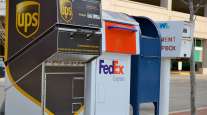UPS Posts 27-Cent Quarterly Loss on Pension Adjustment

UPS Inc. lost $239 million, or 27 cents a share, in the fourth quarter due to a one-time “mark to market” charge on pension assets, decreasing net income by $1.67 billion from what was an otherwise profitable period. For the same issue at the end of 2015, the charge decreased profitability by $79 million.
Excluding the mark-to-market issues, adjusted quarterly net income increased by 1.7% to $1.43 billion, the Atlanta-based parcel carrier said in its Jan. 31 earnings release. Annual revenue grew to a record $60.91 billion from $58.36 billion in 2015.
UPS ranks No. 1 on the Transport Topics Top 100 list of the largest U.S. and Canadian for-hire carriers.
Chairman and CEO David Abney emphasized the adjusted business results in the company’s earnings call, especially the growth of e-commerce opportunities, a high rate of capital expenditures enabling UPS to handle the volumes efficiently and the importance of international trade.
“The international segment [of UPS’ business] delivered another extraordinary performance, while the U.S. managed through considerable changes in product mix,” Abney said in assessing the quarter.
“Our strategies are creating long-term value for both UPS customers and shareowners,” he said.
During the 2015 fourth quarter the company earned $1.33 billion, or $1.48 a share. Quarterly revenue increased to $16.93 billion from $16.05 billion.
When adjusted for pension costs, international package was the major division to post a quarterly profit. The company’s managers said in the conference that international operating income has been growing at a double-digit percentage rate for eight straight quarters.
Domestic package volume grew by 5% to 19.55 million per day in the fourth quarter, the company’s busiest of the year. Ground delivery grew by 5.4%.
Revenue grew at the Supply Chain & Freight division that includes less-than-truckoad carrier UPS Freight, but Chief Financial Officer Richard Peretz said adjusted profits decreased because both parts of the division, freight forwarding and LTL, are facing shippers’ markets as both industries currently have a surplus of freight-handling capacity.
On an annual basis UPS remained profitable despite the pension charge, earning $3.43 billion, or $3.87 a share, down from $4.84 billion, or $5.35.




